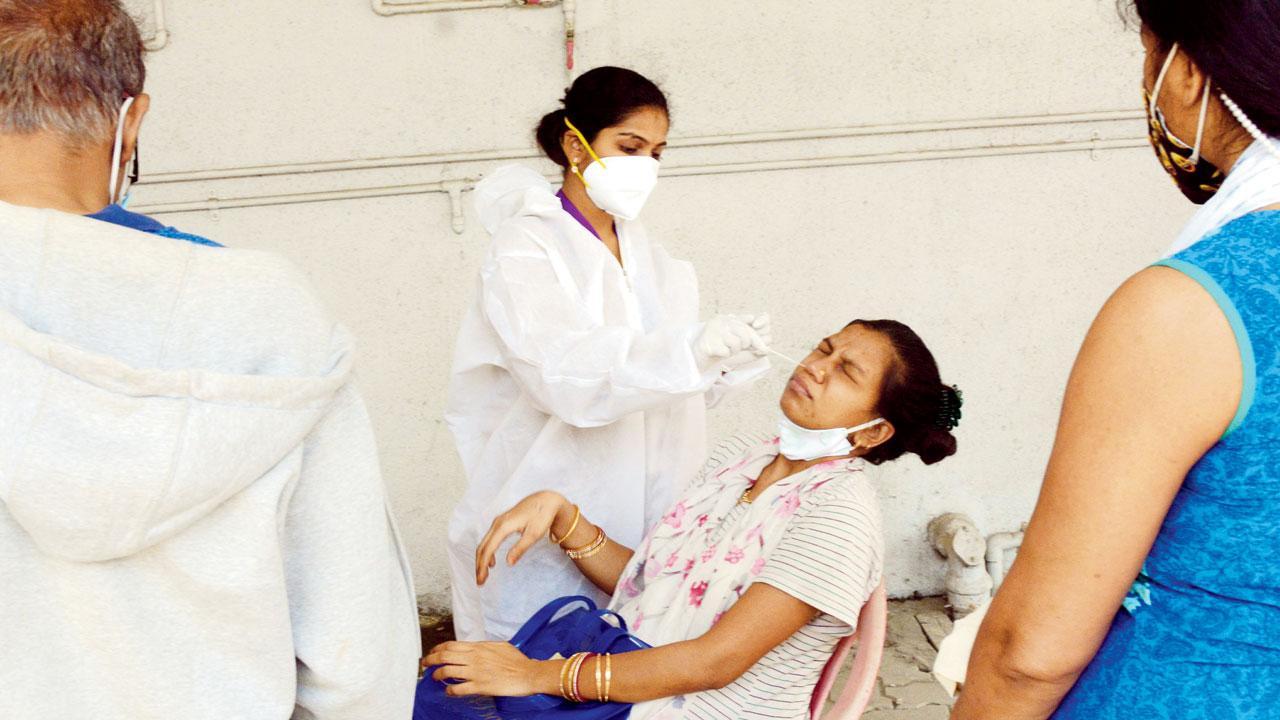Officials say this could be because of people attending gatherings, better contact-tracing

A health worker tests a woman in Goregaon’s (Topiwala) Municipal Maternity Home. Pic/Satej Shinde
Maximum new COVID-19 cases continue to come from buildings and while they were spread out earlier, the trend is changing with siblings and other building residents getting infected. Numbers indicate the trend as buildings with more than five COVID cases increased by almost 50 per cent in the past five days. Slums, too, are seeing increased cases after aggressive screening and testing.
ADVERTISEMENT
A woman gets tested at (Topiwala) Municipal Maternity Home, Goregaon on Thursday. Pic/Satej Shinde
The second wave of the COVID-19 pandemic continues to hit high rises, though minute changes are being noticed. “Earlier the cases in the buildings were spread out, but as we started contact-tracing and testing on a large scale, members from the same families or in the same building started testing positive,” said Prashant Sapkale, assistant commissioner, K East ward that consists of areas from Jogeshwari East to Vile Parle East. There was one sealed building in the entire ward five days ago, now there are nine with more than five cases.
Similarly, the adjacent K West ward (comprising Jogeshwari West to Vile Parle West) had 14 sealed buildings, which increased to 27. “Maximum cases are from buildings. We have areas related to the entertainment industry and the members regularly undergo testing. We seal buildings if there are more than five cases,” said Vishwas Mote, assistant commissioner, K West ward.
Manish Valunj, assistant commissioner, L Ward (Kurla) claimed that even though 80 per cent of the population in his ward stays in slums, 90 per cent of cases are in buildings. “Most of the cases have a history of attending mass gatherings like parties or marriages. We declared two more containment zones (CZ) in slum pockets after detecting four active cases as a precaution,” he said. L ward has sealed eight buildings in the past five days. Similarly, E ward (Byculla) had no sealed buildings and D ward (Malabar Hill, Tardeo) had four of them five days ago. Now, both have 12 sealed buildings each. Sealed buildings went up fron one to 12 in the R South (Kandivli) in this period.
In this period, the total number of CZs has increased from 12 to 16 and buildings with fewer than five cases have increased from 1,849 to 2,237.
Many areas which have large slum pockets are reporting less number of cases. Alaka Sasane, assistant commissioner, H East ward (Santacruz East to Bandra East) told mid-day, “The area has more slum pockets and the cases are below 40 per day. They are mainly coming from buildings.”
Dharavi, which reported zero cases on many days in January, now has 73 active cases. Kiran Dighavkar, assistant commissioner, G North ward (Dharavi, Mahim, Dadar) told mid-day that the cases are random and there isn’t a specific trend so far. “Though after few cases initially, cases are increasing in Dharavi too. But that may be a result of aggressive testing. Wherever we do tracing and testing, the cases get reported. It helps in early detection,” said Dighavkar.
80%
Population of L ward living in slum areas
 Subscribe today by clicking the link and stay updated with the latest news!" Click here!
Subscribe today by clicking the link and stay updated with the latest news!" Click here!






